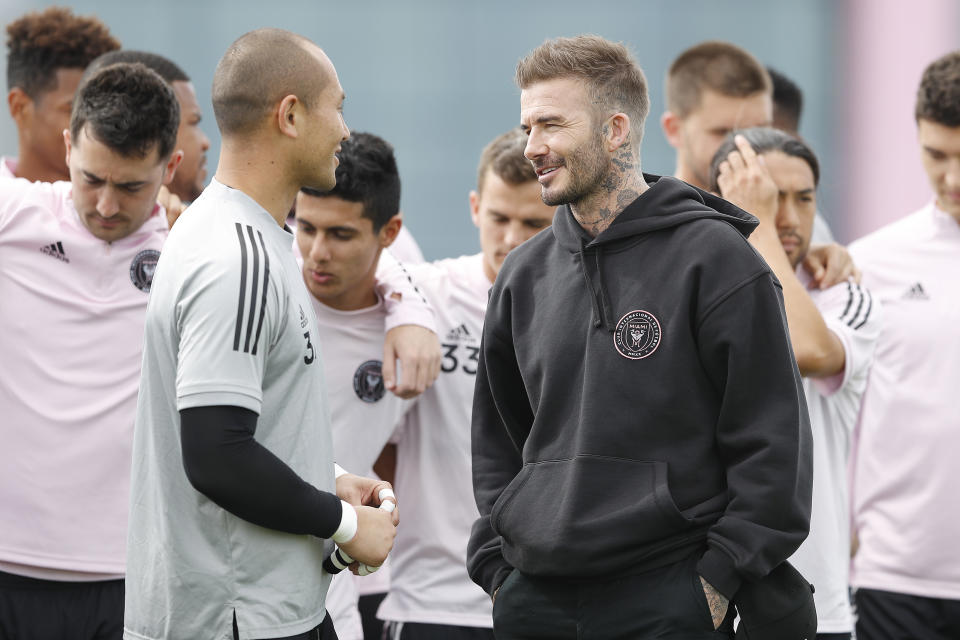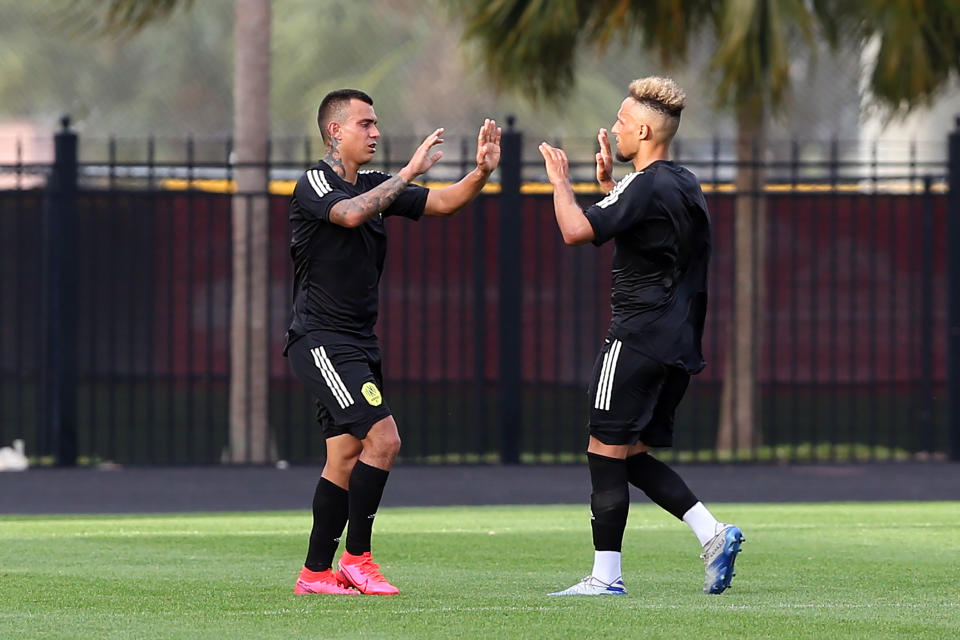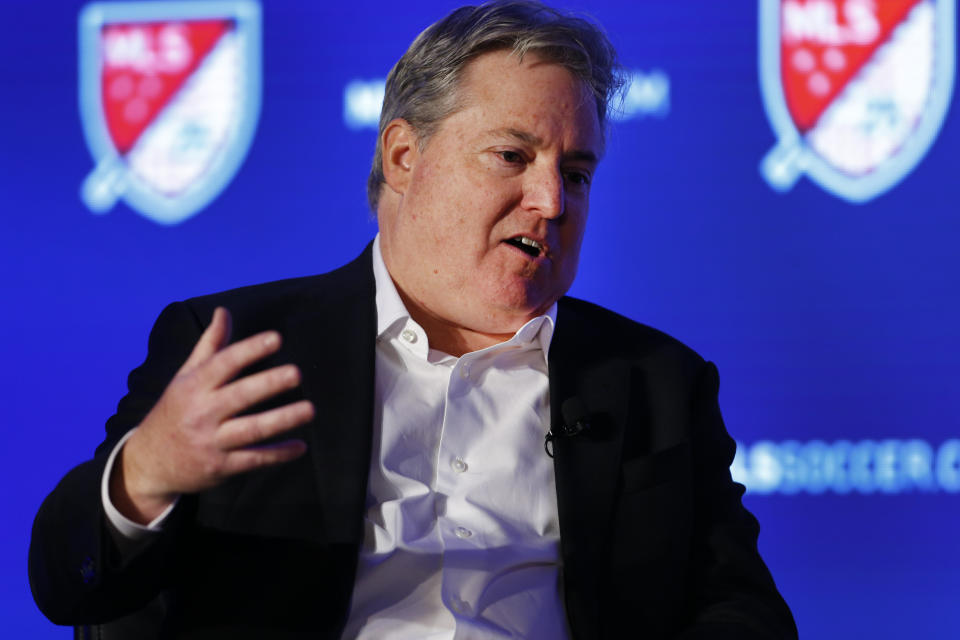26 Thoughts: Beckham brings MLS back to Miami, and will the league eventually overtake MLB and NHL?
Doug McIntyre’s MLS column, 26 Thoughts, parses through the latest insights and inside info from around American soccer.
NEW YORK — It’s hard to know exactly where to begin our first regular MLS column — which once again has a brand-new numerical prefix this year thanks to the arrival of expansion teams in Miami and Nashville — of the league’s 25th-anniversary season, which kicks off this weekend in cities across the United States and Canada.
MLS hosted a gala event Wednesday at a swanky Manhattan hotel to celebrate its milestone campaign, with owners, league and team executives, 200-plus media members and others in attendance. Over the course of six hours, just about every topic was broached and bandied about. We’re going to get to every one of them (and more) below. But the biggest story of the day was undoubtedly the two newcomers, so that’s as good a place as any to start.
The face of Inter Miami’s effort isn’t Mexican national team playmaker Rodolfo Pizarro but rather David Beckham, the former LA Galaxy (and Manchester United, Real Madrid, AC Milan and PSG) star/global fashion icon who is finally making good on the opportunity to own a team that was included in the agreement to bring him here back in 2007.
Pizarro, 26, is a legitimate baller and one of 10 players lured from Liga MX by MLS clubs this winter. But he’s not necessarily the household name many were expecting when Beckham’s plan to bring the league back to South Florida was announced seven years ago, not after none other than Lionel Messi and Cristiano Ronaldo were mentioned as possible recruits. (Beckham was asked about both players during a Tonight Show appearance later Wednesday.)

Still, Inter Miami — which is co-owned by the deeply connected Miami-based Mas family along with billionaires Marcelo Claure and Masayoshi Son — has surrounded Pizarro and fellow designated player Matias Pellegrini, a 19-year-old Argentine hoping to use his stint in North America as a springboard to a top European circuit, with proven MLS veterans such as Luis Robles, Roman Torres, Wil Trapp and Lee Nguyen.
“It’s one thing I learned from Sir Alex Ferguson,” Beckham said of the legendary former Man United manager. “It’s not sometimes all about bringing the biggest names and the biggest players to a club. They have to be the right players that fit into our culture and into our team.”
26 Thoughts
1. Jorge Mas accompanied Beckham to the event and addressed several matters relating to the first-year operation. One of those was Italian club Inter Milan’s attempts to prevent Miami (officially known as Club Internacional de Futbol Miami) from using the “Inter” shorthand.
“It’s a non-issue,” Mas insisted. “We’re not concerned with the trademark issue whatsoever.”
2. This is the league’s second foray into Miami. The Miami Fusion debuted as an expansion team two years after the inaugural 1996 season but were folded (along with the Tampa Bay Mutiny) just months after lifting the Supporters’ Shield in 2001. “The fan base didn’t support the club,” said MLS commissioner Don Garber, who added that even the sort of deep-pocketed investors Inter Miami boasts now wouldn’t have been able to save the Fusion.
“The league was in a different spot and had so many challenges,” Garber said. “To go into a market that would be considered by most a difficult sports market, we didn’t have the strength and capacity and have the momentum and energy to overcome big obstacles. And Miami at the time was a big obstacle.”
3. Inter Miami will play its first home game March 14 against the Galaxy. Asked by Yahoo if he would have any split loyalties, Beckham, who won two MLS Cups in six seasons in Los Angeles, was unequivocal. “Absolutely none,” he said. “I love the Galaxy and I’ll always be a fan, they’ll always have a big place in my heart. But the moment they step foot in our stadium, there’s only one team I’m gonna want to win.”
4. That stadium, by the way, is a 20,000-seat temporary venue in suburban Fort Lauderdale, 30 miles and a 40-minute drive from downtown, built on the site of the Fusion’s old Lockhart Stadium. Inter Miami is still awaiting approval to build a permanent venue in the city proper.
5. “I don’t foresee us being in Fort Lauderdale more than three years,” Mas said. Still, the club’s temporary digs, which will continue to host the club’s academy once the first team leaves, are nothing to sneeze at.
6. “Those guys will spend $120 million on that temporary stadium,” Garber said. That’s more than the permanent soccer-specific stadiums that house the Colorado Rapids, Columbus Crew, FC Dallas, Houston Dynamo, Montreal Impact and San Jose Earthquakes.
7. When he was asked about the difference between MLS now and the 13-team outfit he joined at age 31, Beckham pointed to the influx of younger foreign stars such as Pizzaro. “This should never be a league where players from Europe come to retire,” Beckham said. “That’s not where you want to be.” He’s right. But I’m sure he’d make an exception for Messi or Ronaldo.
8. Inter Miami’s first game is Sunday at Supporters’ Shield holders LAFC [5:30 p.m. ET, ESPN]. Meantime, Nashville will debut at Nissan Stadium in front of a nationally televised audience Saturday night against natural rival Atlanta United (8 p.m. ET, Fox). More than 50,000 tickets have been sold so far, with close to 20,000 still available.

9. Nashville CEO Ian Ayre held the same position with runaway Premier League leaders Liverpool from 2014-17. Ayers noted that the crowd Sunday at the home of the NFL’s Tennessee Titans would be bigger than the one for his Reds debut at Anfield. Nashville will move into its own 27,000-seat arena in 2022.
10. Construction preparations for Nashville’s $250 million soccer stadium were halted by Mayor John Cooper last fall despite being approved by the city council in 2017. Majority owner John Ingram eventually got the deal back on course, but Ayre wasn’t happy about the delay as said as much on Wednesday.
11. “We made a deal with the city — there was no question we had a deal with the city — and then Mayor Cooper made a decision to come back to the [negotiating] table, and I think that’s also OK if you do it in the right fashion,” Ayre said. “But to come to the table having shut down our construction process, and then to continue that for four months, that for me is not the right way to negotiate.”
12. Nashville will have its work cut out to make the playoffs this season. Its initial roster isn’t nearly as strong as Miami’s, let alone MLS heavy hitters like Atlanta, the LA teams, Toronto FC and reigning MLS Cup champ Seattle Sounders.
13. LAFC co-owner Larry Berg made perhaps the biggest headlines of the day when asked where MLS will be in another 10 years. “I think we'll pass baseball and hockey and be the No. 3 sport in the U.S. behind football and basketball,” he said.
14. Soccer as whole? Maybe. But I think it will take MLS a lot longer than than to catch Major League Baseball or the NHL, leagues that have been around for over a century. I’ve written this before, but as someone who has covered the NHL, MLS isn’t even close right now. I can’t see them bridging that gap in 10 years.
15. I’ve written this before, too: If MLS spent what NHL teams do on salaries — the NHL salary cap is $81.5 million this season — it would be the best soccer league in the world.
16. The quality of play in MLS is tied directly to how much money the league spends on its players. I don’t think that gets said enough. So it was pretty cool to hear Berg lay that reality out plainly, even if those comments didn’t get nearly as much play as his other ones.
17. “Whether we can be a top-five league or a top-three league will really come down at the end of the day to money and our ability to compete for players,” he said. ”I think the good news is players want to play here. We're the United States of America. People want to live here. It's an incredible lifestyle. The infrastructure is fantastic. We already have a terrific offering certainly for South American players, etc. but we’re not quite there for European players, and that will come down to money. If we can crack that, then in 10 years we’ll be a top-five league.”

18. The big difference between MLS and the four other major American (or predominantly American) sports leagues is in media rights. The NHL takes in $700 million annually in television money, the lowest of the other four. MLS gets $90 million from its TV partners. They’re going to get a lot more than that when the current rights deals expire in 2022, but you can be sure it won’t be anywhere near $700 million.
“We are entirely upside-down compared to all the other leagues in media as it relates to our revenues,” Garber said. “It’s the smallest piece of the puzzle. I believe undoubtedly that will change going forward.”
19. That’s not to say MLS doesn’t currently get a lot of bang for its buck. “There is a little bit of a disconnect between direct dollar spending and quality,” Garber said, “because we’re more efficient and smarter, frankly, in how we go about investing in our player pool.”
20. Mas essentially echoed Berg’s comments regarding what it would take to make MLS a true global player. Both men were sitting just feet away from Clark Hunt when they spoke. FC Dallas owner Hunt, whose father, Lamar, was instrumental in getting MLS off the ground and keeping it afloat during the league’s turbulent early years, has a reputation for preferring conservative spending and slow, steady growth. Thought that was pretty interesting.
21. About an hour later, Garber acknowledged in clearer terms than I can ever remember him using that from a pure quality-of-play standpoint, MLS still has a long way to go.
“We’re not one of the top handful of leagues in the world, and that’s fairly obvious,” he said. “We’re not close to what the top four or five leagues in the world are.”
22. Bob Bradley made the case for promotion and relegation in MLS in a Sports Illustrated story that posted earlier this week. But during our one-on-one, Garber refused to even entertain the possibility of one day having a two-tiered MLS with promotion and relegation between the divisions, should the league ever grow beyond the 30 teams it’s already committed to. (Austin, Charlotte, Sacramento and St. Louis will arrive over the next few years.)
It was interesting to hear Beckham’s perspective a few minutes later. “It’s been something that I’ve been used to [in Europe],” he said. “It makes it exciting, but when you’re talking about a league that’s only been around for 25 years, there needs to be a real stability in the league before you get to that point.”
23. One might argue that MLS already has promotion, just not relegation. Of the 17 remaining teams that entered the league via expansion, almost half graduated from the lower divisions.
24. Can’t believe I’m saying this, but the Chicago Fire’s new logo is actually growing on me. Still think ditching the red is a huge mistake, though.
25. Speaking of rebranding, the Columbus Crew recently downplayed a report that the club was considering ditching its name and color scheme. “The colors black and gold and the moniker ‘The Crew’ are critical parts of our club’s identity and have been beloved by supporters since 1996,” the team said in a statement. Crew president Tim Bezbatchenko elaborated a little on the matter Wednesday.
“If we were ever to change anything, it would be through a process where we would seek feedback,” he said. “The news that there might be a change was definitely premature. But I also think with new ownership, it’s a responsibility to not just look at the last 25 years, but look at what needs to happen in the next 25 years to be a modern club.”
26. Let’s end this with a bit of news: Atlanta United has instituted a blanket policy against releasing players to national teams outside of official FIFA windows, a club spokesman confirmed to Yahoo Sports on Thursday. That means that unless U.S. under-23 national team coach Jason Kreis holds a roster spot open for him, starting center back Miles Robinson won’t play in next month’s Olympic qualifying tournament in Mexico.
The Five Stripes also refused to let their players participate in South America’s Olympic qualifying tourney and the senior U.S. team’s 2020 January camp.
MLS preview content from Yahoo Sports:

 Yahoo News
Yahoo News 

